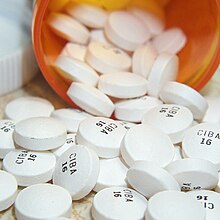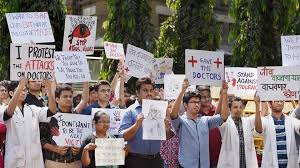"Rx" (℞) is often used as a short form for prescription drug in North America- a contraction of the Latin word "
recipe" (an imperative form of "recipere") meaning "take". Prescription drugs are often dispensed together with a
monograph (in Europe, a Patient Information Leaflet or PIL) that gives detailed information about the drug.
The use of prescription drugs has been increasing since the 1960s. In the U.S., 88% of older adults (62–85 years) use at least 1 prescription drug, while 36% take at least 5 prescription medicines concurrently
Regulation
Australia
- Schedule 1 – Defunct
- Schedule 2 – Pharmacy Medicine
- Schedule 3 – Pharmacist-Only Medicine
- Schedule 4 – Prescription-Only Medicine/Prescription Animal Remedy
- Schedule 5 – Caution
- Schedule 6 – Poison
- Schedule 7 – Dangerous Poison
- Schedule 8 – Controlled Drug (Possession without authority illegal)
- Schedule 9 – Prohibited Substance
- Unscheduled Substances
Like in the UK, the patient visits a
health practitioner, (doctor, nurse, dentist, podiatrist, etc.,), who may prescribe the drug.
Many prescriptions issued by health practitioners in Australia are covered by the
Pharmaceutical Benefits Scheme, a scheme that provides subsidised prescription drugs to residents of Australia to ensure that all Australians have affordable and reliable access to a wide range of necessary medicines. When purchasing a drug under the PBS, the consumer pays no more than the patient co-payment contribution, which, as of January 1, 2017, is
A$38.80 for general patients. Those covered by government entitlements (low-income earners, welfare recipients, Health Care Card holders, etc.) and or under the
Repatriation Pharmaceutical Benefits Scheme (RPBS) have a reduced co-payment, which is $6.30 in 2017. The co-payments are compulsory and cannot be discounted by pharmacies under any circumstances.
Private prescriptions are issued for medicines that are not covered on the PBS or are used
off-label, for indications other than those covered by the PBS. The patient pays the pharmacy for medicines that are privately prescribed.
United Kingdom
- Prescription-only medicines (POM), which may be sold by a pharmacist if they are prescribed by a prescriber
- Pharmacy medicines (P), which may be sold by a pharmacist without a prescription
- General sales list (GSL) medicines, which may be sold without a prescription in any shop
The possession of a prescription-only medicine without a prescription is legal unless it is covered by the
Misuse of Drugs Act 1971.
A patient visits a
medical practitioner or
dentist, who may prescribe drugs and certain other medical items, such as blood glucose-testing equipment for
diabetics. Also, suitably-qualified and experienced nurses and pharmacists may be independent prescribers. Both may prescribe all POMs, but pharmacists may not prescribe Schedule 1 controlled drugs.
District nurses and
health visitors have had limited prescribing rights since the mid-1990s; until then, prescriptions for dressings and simple medicines had to be signed by a doctor. Once issued, a prescription is taken by the patient to a pharmacy, which dispenses the medicine.
Most prescriptions are
NHS prescriptions, subject to a standard charge that is unrelated to what is dispensed. The
NHS prescription fee was increased to £8.60 per item in
Englandon 1 April 2017; prescriptions are free of charge if prescribed and dispensed in
Scotland,
Wales and
Northern Ireland, and for some patients in England, such as inpatients, children, those over 60s or with certain medical conditions, and claimants of certain benefits.The pharmacy charges the NHS the actual cost of the medicine, which may vary from a few pence to hundreds of pounds. A patient can consolidate prescription charges by using a prescription payment certificate (informally a "season ticket"), effectively capping costs at £29.10 per quarter or £104.00 per year.
Outside the NHS,
private prescriptions are issued by private medical practitioner and sometimes under the NHS for medicines that are not covered by the NHS. NHS supply beyond three months' worth is not covered and must be purchased privately. A patient pays the pharmacy the normal price for medicine prescribed outside the NHS.
Survey results published by
Ipsos MORI in 2008 found that around 800,000 people in England were not collecting prescriptions or getting them dispensed because of the cost, the same as in 2001.
United States
In the United States, the
Federal Food, Drug, and Cosmetic Act defines what substances require a prescription for them to be dispensed by a pharmacy. The federal government authorizes physicians, psychiatrists,
physician assistants,
nurse practitioners and other
advanced practice nurses, veterinarians, dentists, and optometrists to prescribe any controlled substance. They are then issued unique
Drug Enforcement Act numbers; many other mental and physical health technicians, including basic-level
registered nurses,
medical assistants, emergency medical technicians, most psychologists, and social workers, for example, do not have the authority to prescribe any controlled substance.
The
Controlled Substances Act (CSA) was enacted into law by the
US Congress of the United States in 1970. It is the federal drug law that regulates manufacture, importation, possession, use, and distribution of certain substances. The legislation classes substances into five schedules, with varying qualifications for each schedule.
Misuse or abuse of prescription drugs can lead to adverse drug events, including those due to dangerous drug interactions. According to one study, as many as 15% of older American adults are at risk of potential major interactions between drugs.
The package insert for a prescription drug contains information about the intended effect of the drug and how it works in the body. It also contains information about side effects, how a patient should take the drug, and cautions for its use, including warnings about allergies.
As a general rule,
over-the-counter drugs (OTC) are used to treat a condition that does not need care from a healthcare professional if have been proven to meet higher safety standards for self-medication by patients. Often, a lower strength of a drug will be approved for OTC use, but higher strengths require a prescription to be obtained; a notable case is
ibuprofen, which has been widely available as an OTC
pain killer since the mid-1980s, but it is available by prescription in doses up to four times the OTC dose for severe pain that is not adequately controlled by the OTC strength.
By law, American pharmacies operated by "membership clubs" such as
Costco and
Sam's Club must allow non-members to use their pharmacy services and may not charge more for these services than they charge as their members.
Physicians may legally prescribe drugs for uses other than those specified in the FDA approval, known as
off-label use. Drug companies, however, are prohibited from marketing their drugs for off-label uses.
Large US retailers that operate pharmacies and pharmacy chains use inexpensive generic drugs as a way to attract customers into stores. Several chains, including Walmart, Kroger (including subsidiaries such as Dillons), Target, and others, offer $4 monthly prescriptions on select generic drugs as a customer draw.
[16] Publix Supermarkets, which has pharmacies in many of their stores, offers free prescriptions on a few older but still effective medications to their customers. The maximum supply is for 30 days.
Prescription painkillers have been found to be extremely addictive, and unintentional poisoning deaths in the United States have skyrocketed since the 1990s. Prescriber education guidelines as well as patient education,
prescription drug monitoring programs and regulation of pain clinics are regulatory tactics which have been used to curtail opioid use and misuse.
Expiration date
The expiration date, required in several countries, specifies the date up to which the manufacturer guarantees the full potency and safety of a drug. In the United States, expiration dates are determined by regulations established by the FDA. The FDA advises consumers not to use products after their expiration dates.
A study conducted by the U.S. Food and Drug Administration covered over 100 drugs, prescription and over-the-counter. The res Joel Davis, a former FDA expiration-date compliance chief, said that with a handful of exceptions—notably
nitroglycerin,
insulin, some liquid antibiotics; outdated
tetracyclines can cause
Fanconi syndrome—most expired drugs are probably effective.
The
American Medical Association (AMA) issued a report and statement on Pharmaceutical Expiration Dates. The
Harvard Medical School Family Health Guide notes that, with rare exceptions, "it's true the effectiveness of a drug may decrease over time, but much of the original potency still remains even a decade after the expiration date".
The expiration date is the final day that the manufacturer guarantees the full potency and safety of a medication. Drug expiration dates exist on most medication labels, including prescription, over-the-counter (OTC) and dietary (herbal) supplements. U.S. pharmaceutical manufacturers are required by law to place expiration dates on prescription products prior to marketing. For legal and liability reasons, manufacturers will not make recommendations about the stability of drugs past the original expiration date.
Cost
Prescription drug prices including generic prices are rising faster than the average rate of inflation. To subsidize prescription drug costs, some patients have decided to buy medicine online.
Environment
Traces of prescription drugs — including
antibiotics, anti-convulsants, mood stabilizers and sex hormones — have been detected in drinking water.















